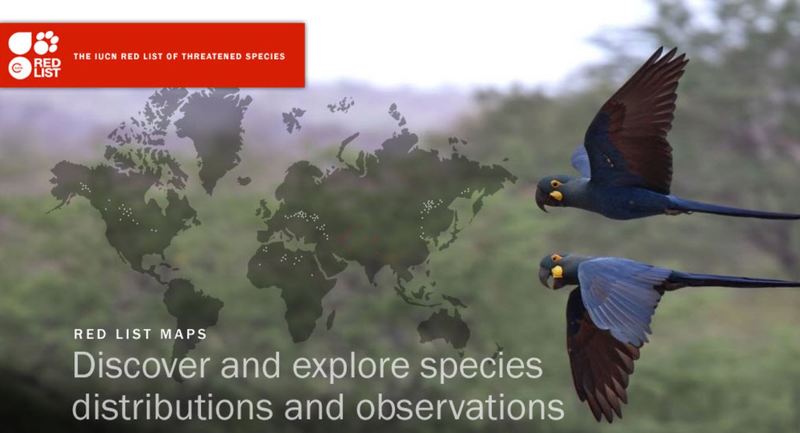What's New
Along with pages being regularly updated to reflect the new data available in each Red List update, new pages, tools and functionality are added to The IUCN Red List website at any time throughout the year. The most recent updates and additions to the Red List website are listed below.
For a list of previous updates and additions (since the start of 2020), click here.
New and updated pages |
|
| Data Repository | sRedList |
Publications |
|
|
|
|
Red List tools and guidance documents |
|
| Red List Guidelines: version 16 | |
Assessments |
|
|
|
|
Summary Statistics page
Each time The IUCN Red List is updated, the Summary Statistics page (in the Resources and Publications section) is also updated to provide statistics for the most recent version of the Red List. The Summary Statistics page also includes links to the automated statistics tables. Note that from the 2022-1 Red List onwards, the calculation for proportion of threatened species now includes threatened (CR, EN and VU) and Extinct in the Wild (EW) species.
Spatial Data Download page
Each time The IUCN Red List is updated, the Spatial Data Download page (in the Resources and Publications section) is also updated to provide all the current map data for various groups of species (including polygon spatial data and point data, where available).
SIS Self-teach Tools & Guidance Documents
 The Species Information Service (SIS) is the data management system used by IUCN to store and manage species accounts and assessments for publication on the IUCN Red List. Some SIS users have access to data management tools to help them manage assessment projects.
The Species Information Service (SIS) is the data management system used by IUCN to store and manage species accounts and assessments for publication on the IUCN Red List. Some SIS users have access to data management tools to help them manage assessment projects.
A set of guidance documents was created to help these users make the most of the tools and functions in SIS. These documents are now available to download from the SIS Self-teach Tools and Guidance Documents page.
Data Repository
 Spatial and tabular data from The IUCN Red List are used in many analyses and the results published in scientific papers. Since the IUCN Red List is regularly updated, it is not practical for people to rely on exporting current assessment data to replicate these analyses. Therefore, in 2023, a Data Repository page was added to the Red List website to hold the Red List datasets used in analyses and publications that are primarily lead by people associated with IUCN, making these permanently available.
Spatial and tabular data from The IUCN Red List are used in many analyses and the results published in scientific papers. Since the IUCN Red List is regularly updated, it is not practical for people to rely on exporting current assessment data to replicate these analyses. Therefore, in 2023, a Data Repository page was added to the Red List website to hold the Red List datasets used in analyses and publications that are primarily lead by people associated with IUCN, making these permanently available.
sRedList
 In October 2023, the sRedList tool was launched. This Red List tool is a user-friendly web-interface, which allows users to download and filter occurrence records, to create distribution maps, to calculate area of occupancy (AOO), to map trends in area of habitat or forest cover, to extract lists of countries of occurrence and habitat preferences, or to assess severe fragmentation. The new sRedList page on the IUCN Red List website includes a link to the sRedList website and tool.
In October 2023, the sRedList tool was launched. This Red List tool is a user-friendly web-interface, which allows users to download and filter occurrence records, to create distribution maps, to calculate area of occupancy (AOO), to map trends in area of habitat or forest cover, to extract lists of countries of occurrence and habitat preferences, or to assess severe fragmentation. The new sRedList page on the IUCN Red List website includes a link to the sRedList website and tool.
Species Richness and Rarity-weighted Richness Data
A new Species Richness and rarity-weighted Richness Data page was added to the Red List website in 2023, allowing users to download spatial data files (and map images) for species richness and rarity maps based on the IUCN ranges for amphibians, birds, mammals and reptiles.
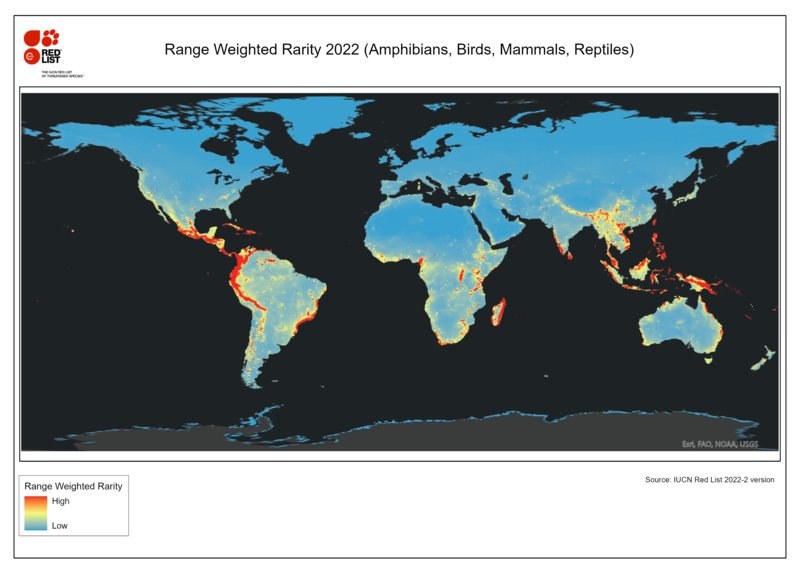
State of the World's Amphibians: The Second Global Amphibian Assessment
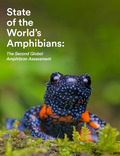 The second global amphibian assessment was released in October 2023, and can be downloaded from here. This report provides an update on the status of the world's amphibians, the pressures upon them, and the solutions needed for massively scaling up their conservation. Through the second Global Amphibian Assessment, more than a decade of data from research on amphibians by over 1,000 experts was compiled to assess the extinction risk of 8,011 species.
The second global amphibian assessment was released in October 2023, and can be downloaded from here. This report provides an update on the status of the world's amphibians, the pressures upon them, and the solutions needed for massively scaling up their conservation. Through the second Global Amphibian Assessment, more than a decade of data from research on amphibians by over 1,000 experts was compiled to assess the extinction risk of 8,011 species.
Petitions: Migratory Monarch Butterfly
 All IUCN Red List assessments are open to challenge, and a petitions process is in place to handle cases where there is disagreement on an assessment that cannot be resolved through informal discussions. In 2023, a petition was lodged against the assessment for the Migratory Monarch Butterfly (Danaus plexippus ssp. plexippus). the results of that petition were released on the Petitions Page in September 2023. The assessment for this butterfly was changed, based on the results of the petition, in the IUCN Red List update on 11th December 2023.
All IUCN Red List assessments are open to challenge, and a petitions process is in place to handle cases where there is disagreement on an assessment that cannot be resolved through informal discussions. In 2023, a petition was lodged against the assessment for the Migratory Monarch Butterfly (Danaus plexippus ssp. plexippus). the results of that petition were released on the Petitions Page in September 2023. The assessment for this butterfly was changed, based on the results of the petition, in the IUCN Red List update on 11th December 2023.
Red List Guidelines: version 16
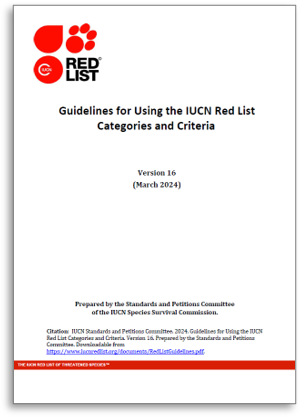 In March 2024, the Guidelines for Using the IUCN Red List Categories and Criteria were updated to version 16. To download the current version of the guidelines, click here.
In March 2024, the Guidelines for Using the IUCN Red List Categories and Criteria were updated to version 16. To download the current version of the guidelines, click here.
Supplementary Information Templates
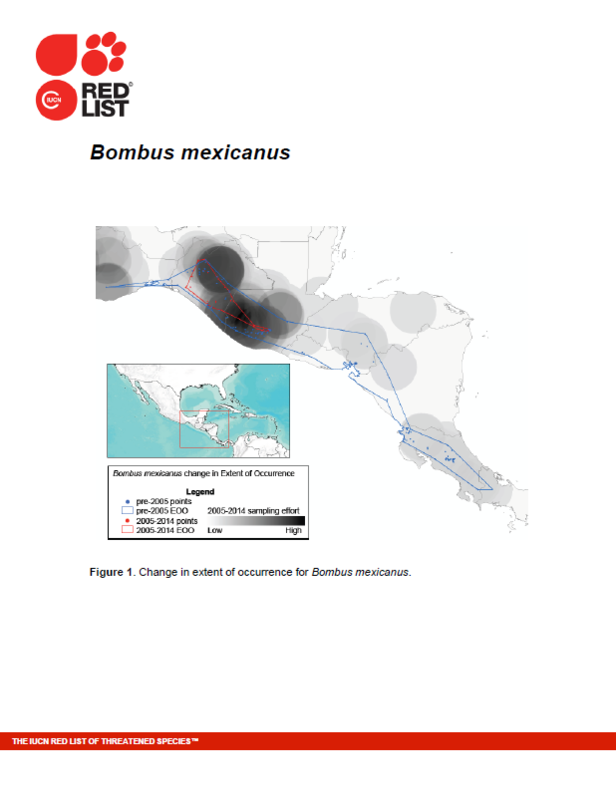 Assessors working on Red List assessments sometimes need to attach supplementary information documents containing additional information and data that cannot be included within the main assessment. A set of standard templates is now available on the Supporting Information Guidelines page.
Assessors working on Red List assessments sometimes need to attach supplementary information documents containing additional information and data that cannot be included within the main assessment. A set of standard templates is now available on the Supporting Information Guidelines page.

